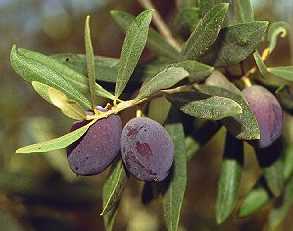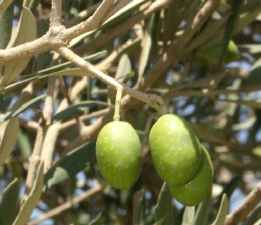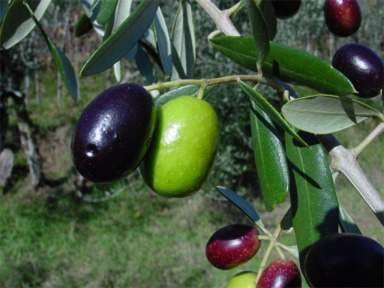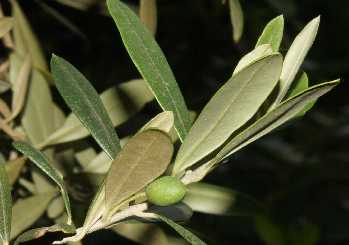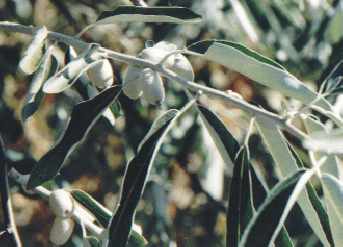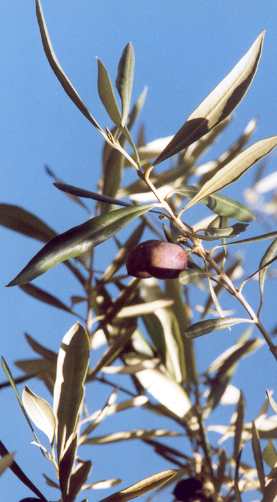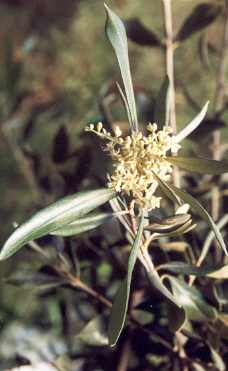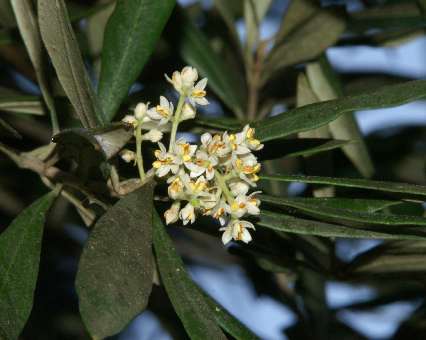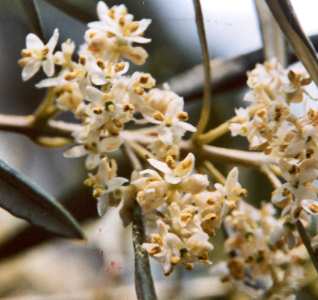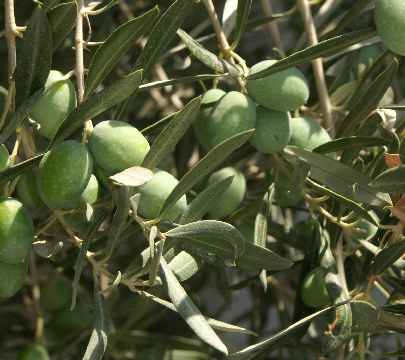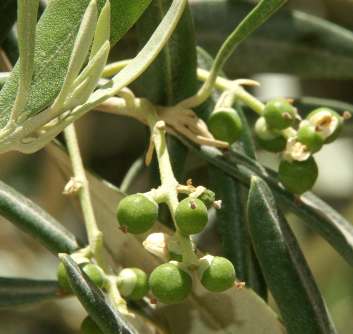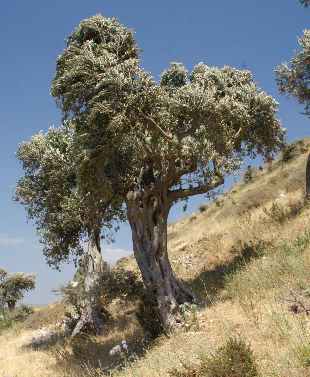
|
| Olive tree near St. Petrus Church in Antakya (ancient Antioch), Turkey |
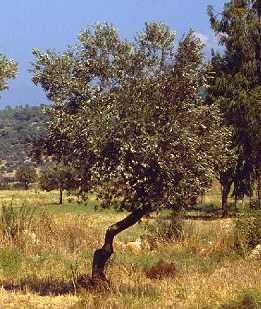
|
| Olive tree |
Olives are grown in the whole Mediterranean region and are a most important
part of the diet in all Mediterranean countries: Olive oil is ubiquitously used
as a cooking medium, and pickled olives are popular both a spice and as a
snack.
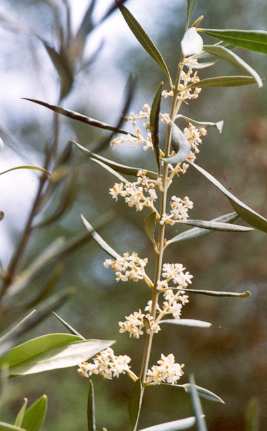
|
| Olive flowers |
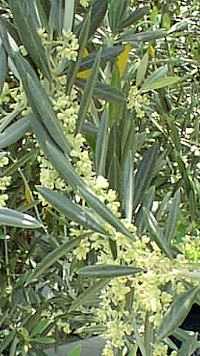
|
| Olive branch with flowers |
Pickled olives are either black or green, depending whether they have been harvested unripe or ripe. Green olives are plucked unripe and either repeatedly watered or treated with concentrated lye before pickling; by the latter procedure, which dates back to ancient Rome, bitterness is greatly reduced and the texture is improved. Black olives are plucked ripe; in Greece, they are treated with salt or undergo lactic fermentation, which results in an intense flavour. The brine olives are pickled in is often further enhanced by addition of some herbs (thyme, oregano) or garlic.
Pickled olives are a common decoration for cold dishes and tasty sauces. Of course, they fit best to specialties from the Mediterranean. Olive’s flavour can be enhanced by preparing a paste of finely cut and squeezed olives with good olive oil. Adding anchovies (fermented fish), garlic and capers to such a paste from black olives and olive oil gives tapenade, a Southern French condiment and appetizer which tastes best with crispy baguettes.
The use of olives for warm dishes is more or less restricted to Mediterranean cuisines. Tomato sauces containing onion, garlic, capers and green (or sometimes black) olives are characteristic of Italy; they may be made even tastier by adding fresh herbs (basil, oregano and rue). Sauces of this kind may be used to cook meat or poultry or they can simply be served together with noodles (pasta). Italian pizza is often prepared with (usually black) olives, mostly so in Southern Italy (see oregano).
Far more important than pickled olives is, however, olive oil, whose production
consumes about 90% of olive acreage. The best quality, native olive oil
extra (formerly known by the Italian term extra vergine),
is quite
variable in appearance and taste; after having tried some oils, most people
develop different preferences. Some oils are subtle and flowery, others intense
and fruity. It is probably a good idea to stock a few different varieties in
the kitchen.
There is a huge variety in olive oils, both regarding colour and flavour. The multitude of olive oil qualities can, essentially, be reduced to two factors: Quality of the underlying olives, and method of extraction.
Best extra vergine olive oil is produced from several
different varieties of olives, the fruits being picked all at the same
time, at different stages of ripeness. Furthermore, climate, altitude
and soil influence the flavour of the oil. Last of all, olives must
be extracted as soon as possible after plucking, and in the meantime,
they require dry storage and careful handling to avoid the formation
of marks on the fruits.
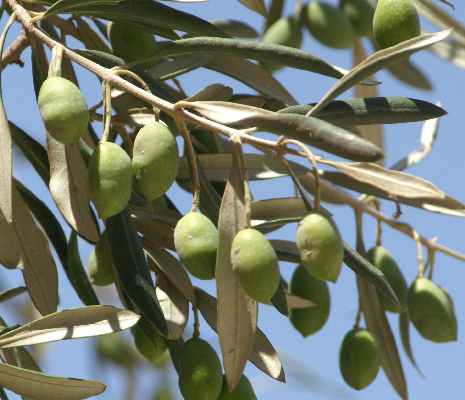
|
| Olive branch with unripe fruits |
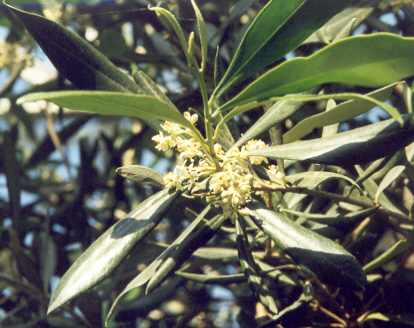
|
| Olive branch with flowers |
When extracting olives, one encounters a problem rarely found with
other oil crops: High water content. By grinding, one does not arrive at
a dry mass suitable for high-
Native olive oil extra should be used for cold foods only, since the
flavour detoriates on heating: Volatile constituents may evaporate or react
toward unpleasantly flavoured compounds. Native olive oil, which is from the
beginning poorer in aroma, is well suited for careful shallow-frying.
Nevertheless, even native olive oils does not tolerate the high temperatures
typical of deep-frying, for which therefore other oils are better choice
(e. g., peanut or sunflower oil); when using olive oil, one has to fry
at comparatively low temperatures that do not allow for efficient browning
of meats or vegetables. To improve the smoke point, one can add butter or
better butter fat, which also may be beneficial for the flavour.
Many of the dishes of Southern Europe, Western Asia and Northern Africa owe
much of their character to extra vergine olive oil. It is used
for salads, for the Near East chick pea paste hummus (see sesame), cold appetizers (in Israel collectively known
as mezes) and the salads of the Eastern Mediterranean
based on bulgur, this is, cracked and precooked
wheat (tabbouleh, kısır;
see parsley). Furthermore, olive oil is used for
spicy dips like Egypt dukka (see
thyme) or the famous Provençal garlic mayonnaise aïoli. Italian
noodles (pasta) are often boiled with a spoonful of olive oil
to prevent them from sticking together; before serving, olive oil is often
spooned over to increase the flavour.
By using olive oil instead of bland vegetable oil, everyday dishes like
shallow-fried vegetables (zucchini, aubergines, capsicum) get a typically
Mediterranean character, even more if they are served with yoghurt or tomato
sauce. A famous example from Turkey is imam
bayıldı (
The taste of olive oil harmonizes excellently with the fragrance of
Mediterranean herbs. In the Mediterranean countries, olive oil is often
flavoured with branches of rosemary, lavender, tarragon or, on
Cyprus, with fresh capers. Most fresh herbs can be
preserved in olive oil; their aroma compounds dissolve better in oil than in an
aqueous medium. A most famous recipe of this kind is pesto, a
paste of ground basil leaves in olive oil.
Not only the gentle fragrance of fresh herbs, but also the pungency of chiles has an affinity for a fatty medium. In Italy,
small but powerful chiles (peperoncini) are often used to
convert olive oil into a fiery condiment (olio santo or olio piccante).
I have seen a comparable chile
oil in Arizona. According to personal taste, it may be used drop by drop or
tablespoon by tablespoon. In some variants of the Yemeni condiment zhoug (see coriander), the heat of
green chiles is transmitted by olive oil.
native olive oil
or even native olive oil extra
if the free
acid level permits.
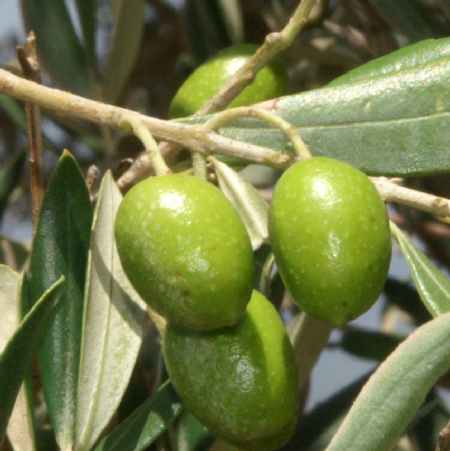
Unripe olives
the İmam fainted
, probably for
pleasure), aubergine fried in olive oil stuffed with a spicy paste of tomatoes
and garlic.
Slow frying of vegetables in olive oil consumes a lot of the oil; sometimes,
it is possible to deep-fry (or grill) the vegetables instead, pat them dry and
sprinkle some with high-quality olive oil before serving.
